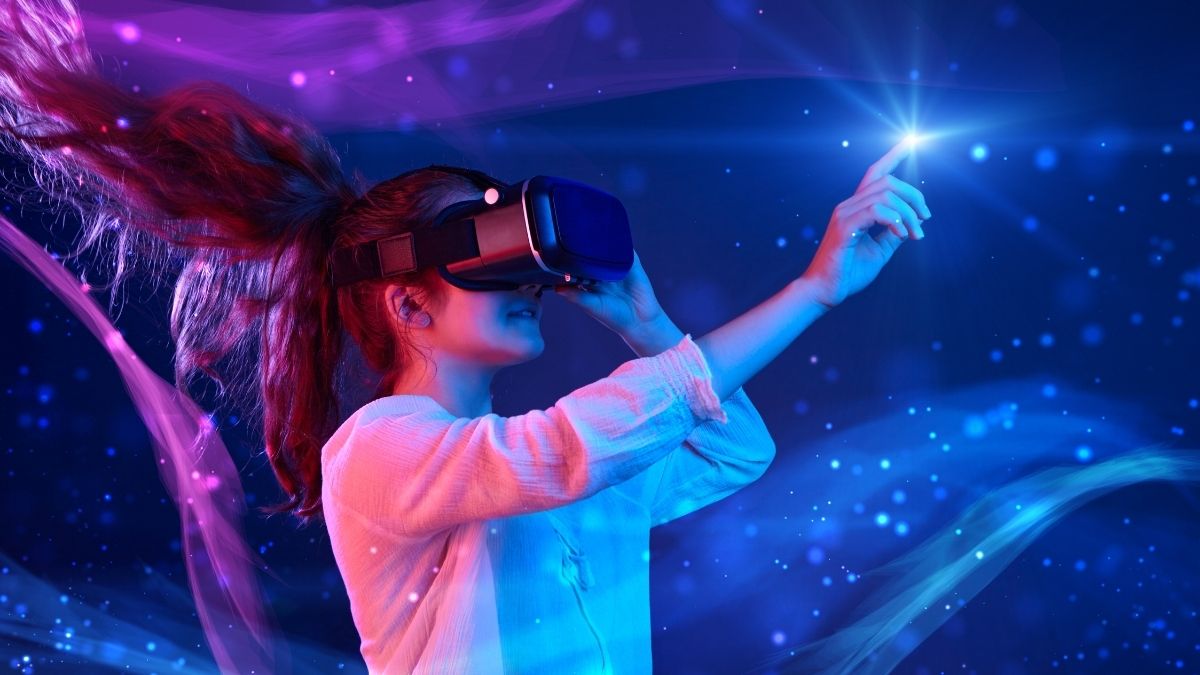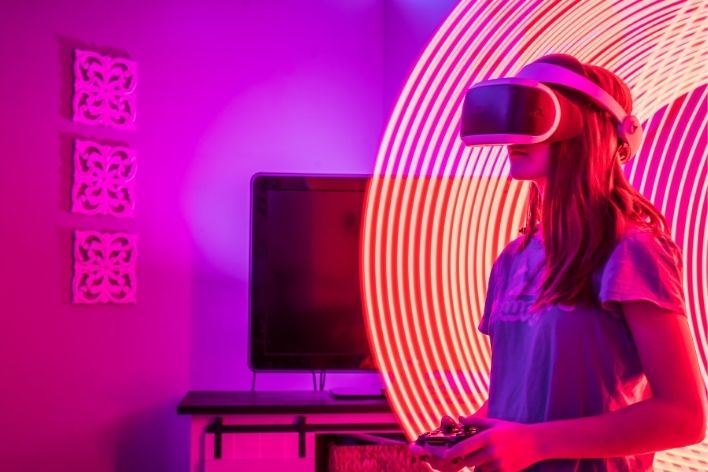The Benefits of Using Virtual Reality for Immersive Learning Experiences

What if you were able to visit Mars and walk on its surface, swim with dolphins, or travel back in time to find out what the dinosaurs looked like? All this and much more is possible with the enabling technology of virtual reality. Here, we will discuss all the benefits of virtual reality in education with which children and students can immerse themselves in a different reality, understanding how to perceive the world in a changed light. So, let's leap!
What is Virtual Reality?
But first, let's get a few things straight about what VR is. Virtual reality is a technology that allows you to fully immerse yourself into a computer-generated world like you were there. Using special headsets or goggles, you'll be able to look around and react with your 3D worlds. Pretty cool, huh? Imagine walking through ancient ruins or flying in space. And that is all from your classroom!
What is Immersive Learning?
Well, we are now conversant with virtual reality; hence, we should now find out what immersive learning is. This is a teaching methodology that involves the placement of students in realistic environments wherein they can actively take part in the learning process. You're not reading about something or listening to a lecture; you are experiencing it for real.
Benefits of Virtual Reality in Education
So, what are some of the most important benefits of virtual reality in learning? Well, let's consider the pretty cool advantages of VR for education!
1. Increased Engagement
One of the great merits of virtual reality is how it grabs your attention. A VR headgear is not like entering an entirely new world, full of thrills and engagements. Such immersion makes learning excitingly adventurous, making one participate and look a little deeper into the topics.
2. Real-world Applications
With VR, you can experience the real world of circumstances you would otherwise not have access to. For instance, medical students can train in surgeries in a simulated environment, while science students can perform virtual experiments with no risks associated. This will be hands-on and, with this approach, you will understand concepts more and see their relevance in practical terms.
3. Safe Learning Environment
Virtual reality allows learners to learn in a safe environment especially when the topic being studied entails risk factors such as science experiments or physical education. In such settings, one can engage in high-risk activities and make mistakes while learning from them without losing anything in life. This factors towards exploration and creativity.
4. Customized Learning Experience
Every student learns differently, and VR can serve every learning style. If you're a visual learner, then viewing things in three dimensions can make all the difference. If you're an actual doer, doing some things because you prefer not just to read about them, then VR lets you interact with the material. This is what leads everyone to learn at their own pace.
5. Breaking the Geographical Barriers
Travel anywhere in the world with VR while sitting in your classroom. Do you wish to visit the Great Wall of China? Or perhaps the Amazon rainforest? Virtual reality is the way to go. This lets you reach out to knowledge and experiences to form your education to a broader dimension.
6. Enhances Information Retention
Studies have indicated that students who learn by using VR remember better the information learned the conventional way. As long as your senses are on and you have engaged in participation in the learning processes, there is a huge probability that you retain information. This is what fuels grades and more profound comprehension.
7. Teamwork and Collaboration
Many VR experiences enable the feature to have the ability to host multiple users within the session at one time. This means you can engage in group projects with classmates even if you are geographically far apart. A virtual collaboration space can help improve teamwork skills and make learning more enjoyable.
8. Creativity Boost
Using VR can inspire creativity. The virtual world lends itself to experimentation in ideas and "out-of-the-box" thinking, especially when designing a product, creating art, or trying to solve problems; so here's one more thing to do with VR: develop some tech skills!
9. Developing Tech Skills
Today, with all its digital paraphernalia, the common denominator is technology. Here in virtual reality, you are learning academic subjects as well as getting comfortable with advanced technology, which will help in employment opportunities in the future.
10. Accessibility for All
Virtual reality makes learning accessible to all students with various needs. For instance, the physically challenged can experience activities they would fear or not be able to have easy times in life living through it. Therefore, VR provides an inclusive training environment wherein everyone learns.
Advantages and Disadvantages of Virtual Reality
Although there are numerous benefits of virtual reality, some merit and demerit discussions about virtual reality in education cannot be avoided. Let's discuss some of its downsides now.
Benefits
Experiential Experiences: Virtual reality provides an exciting experience about learning because subjects come alive.
Hands-On Learning: It allows the students to practice skills in a protective environment.
Innovative Teaching Tools: Virtual reality can add excitement to traditional teaching techniques and make learning exciting.
Disadvantages
Cost: It is a very expensive affair to set up VR systems that may not be very accessible to most people.
Technical Issues: The VR technology may catch technical glitches, which can be very frustrating for users.
Limited Content: Despite the growing library of educational VR content, it does not address all the subject or topic matter.
Motion Sickness: Some students receive a form of discomfort or motion sickness while accessing the VR.

How to Integrate Virtual Reality in Learning
Knowing the benefits of virtual reality and the pros and cons, it's time to talk about how schools can effectively integrate VR into their curriculum.
1. Curriculum Integration
VR classes can be undertaken for any subject, such as history, science, and art. For instance, history classes can have virtual field trips to historical places; science classes can do virtual experiments.
2. VR Labs
A school can have a fully equipped VR lab where the student can explore the various subjects in a headset using software. This allows people to conduct practical experiments that, in turn, lead to a higher understanding
3. Training and Workshops
The teachers in the school should be trained on how to deploy the VR use within the class setting. The workshops can give the teachers ideas and resources and the aspect of how to include the VR in class by ideas provided.
4. Collaboration with VR Companies
Schools can collaborate with VR firms on matters of accessing educational content and software. This should give the students the ideal learning experience matching the curriculum.
5. Engage Students in Selecting Interactions in VR
It can very much be the student who would participate in deciding the desired experience in VR. The more a student is engaged, the more pumped up and interested he or she will be in class.
Conclusion
Some of the benefits of virtual reality for education summed it up as being long and exciting! There is engagement in much deeper ways than before; a safe learning environment; concepts in learning interactions are changed; and a head start for schools to ready their students for a future bound with creativity, thinking, and technology.
The next time you hear about the benefits of virtual reality, marvel at all that it could hold for your education. Whether in the depths of the ocean or a castle in medieval days, it can be taken. That is even more than I can imagine, but what will the world wonder at in the future?
FAQs
How does VR improve learning?
VR improves learning by improving experience to increase participation and engagement, allowing real practice for a better understanding of complex concepts via simulations.
How can teachers incorporate VR into the classroom?
Teachers can make use of VR for giving virtual field trips, the simulation of real life, and interactive lessons in science, art, and history in an interactive manner that the child would not otherwise get a chance to explore.
How effective is VR training?
This gives learners the chance to work through scenarios in a risk-free environment, making VR training exceptionally effective: often leading to higher retention of information, increased engagement, and better skill acquisition.
What can you do with technology to make learning about your interests more immersive?
You may use technologies like VR and AR and interactive apps to explore interests through virtual experiences, online workshops, and even gamified learning platforms that bring subjects to life.
Discover more exciting ways to make learning fun—explore our site for engaging resources and activities today!
Related Blogs
Virtual Labs to Enhance Science Education: Learn about how using Virtual Labs can be useful to enhance Science Education.
Other Related Sections
NCERT Solutions | Sample Papers | CBSE SYLLABUS| Calculators | Converters | Stories For Kids | Poems for kids| Learning Concepts I Practice Worksheets I Formulas | Blogs
Admissions Open for 2025-26
CBSE Schools In Popular Cities
CBSE Schools in Bangalore
CBSE Schools in Mumbai
CBSE Schools in Pune
CBSE Schools in Hyderabad
CBSE Schools in Chennai
CBSE Schools in Gurgaon
CBSE Schools in Kolkata
CBSE Schools in Indore
CBSE Schools in Sonipat
CBSE Schools in Delhi
CBSE Schools in Rohtak
CBSE Schools in Bhopal
CBSE Schools in Aurangabad
CBSE Schools in Jabalpur
CBSE Schools in Jaipur
CBSE Schools in Jodhpur
CBSE Schools in Nagpur
CBSE Schools in Ahmednagar
CBSE School In Tumkur

